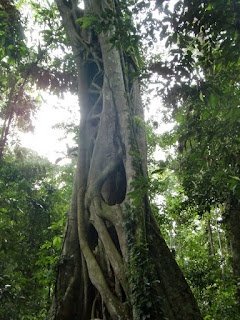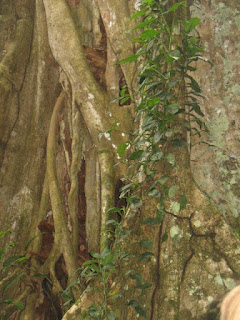We all made the grade and then enjoyed a leisurely ride in the boat.
 To avoid the blistering sun which could burn your skin in minutes, we found a shady spot for lunch along the river bank.
To avoid the blistering sun which could burn your skin in minutes, we found a shady spot for lunch along the river bank.Before I go any further, I want to share something with you that may express the beauty of what I experienced on the Amazon. Some of you may have wondered what Al was reading while we were on the bus, the train and boats, well I want to share with you some of what he read. This is a quote from one of Al's favorite authors, the great Harvard biologist by the name of Edward O. Wilson who wrote BIOPHILIA: The human bond with other species.
"I savored the cathedral feeling expressed by Darwin in 1832 when he first encountered tropical forest near Rio de Janeiro ("wonder, astonishment & sublime devotion, fill & elevate the mind"). And once again I could hold still for long intervals to study a few centimeters of tree trunk or ground, finding some new organism at each shift of focus. The intervals of total silence, often prolonged, became evidence of the intensity of the enveloping life. Several times a day I heard what may be the most distinctive sound of the primary tropical forest: a sharp crack like a rifle shot, followed by a whoosh and a solid thump. Somewhere a large tree, weakened by age and rot and top heavy from layers of vines, has chosen that moment to fall and end decades or centuries of life. The process is random and continuous, a sprinkling of events through the undisturbed portion of the forest. The broad trunk snaps or keels over to lever up the massive root system, the branches plow down through the canopies of neighboring trees at terrifying speed, and the whole thunders to the ground in a cloud of leaves, trailing lianas, and fluttering insects. There may be a hundred thousand trees within earshot of any place the hiker stands in the forest, so that the odds of hearing one coming down on a given day are high. But the chance of being close enough to be struck by any part of the tree is remote, comparable to that of stepping on a poisonous snake or coming round the bend of a trail one day to meet a mother jaguar with cubs. Still, the lifetime risk builds up cumulatively, like that in daily flights aboard single-engined airplanes, so that those who spend years in the forest count falling trees as an important source of danger."
Only those of you who shared this experience on the Amazon can relate to the excitement of seeing a jaguar track wondering if it was fresh, the frightening sound of the howling monkeys and the horror of witnessing the guide kill a poisonous snake with a machete while wearing nothing but shorts and flip flops!
Next stop Cusco!





















No comments:
Post a Comment